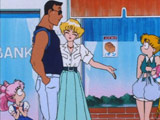

Quick Links:
Sailor Moon SuperS, Volumes 2-4: Amazon Trio Arc
It's often said that absence makes the heart grow fonder. For the most part, this observation is true, as that delightful rose tint of nostalgia begins to cover the lenses of retrospect. With this in mind, I have taken it upon myself to revisit Sailor Moon SuperS one year, two death threats, and roughly eighteen wishes of personal injury on myself and my nonexistent wife (Some of these people must think that I'm charming, or that wives can be had at 2 for a buck at 7-Eleven) later. In the past year, I must say that my opinions on the first six episodes have changed very little: they are still forced, cheesy, and boring. However, what lay beyond the initial snoozefest proves to be goofy, humorous, and, dare I say, fun to watch.
The series begins to show massive improvement when the spotlight is wrestled away from the pink-haired helium addict known as Chibiusa. The stories begin to spread among the rest of the cast who have, for the most part, been out of commission. Of course this doesn't mean that the Amazon Trio is more than a gang of fruity rapists, or that viewers can't time their watches by the show's recycled animation theatres. On the contrary, the formula itself has changed very little between episodes six and seven. It's what the show's done within those limits that changed an unbearable mess into campy (in a good, Evil Dead way) fun.
The senshi have apparently abandoned the idea of telling a moving, epic tale as the whole Pegasus plotline is shuffled off to the back burner. Yes, the circus folk (carnies?) are still searching for Pegasus in peoples' dreams. However, this really doesn't go very far, and serves more as an excuse to get the Amazon Trio out into the world in (often failed) attepts to seduce women with "beautiful dreams," thus providing an impetus for the bad guys, and plenty of time to show the not-so-intrepid heroines at play. By "at play," I mean squabbling, stalking "suspicious" people, or generally trying to solve the problems of the victim of the week (by coincidence, of course; there are no obvious plot elements working here). These sequences don't have the genius writing of, say, City Hunter, but the comedic timing and general personality clashes come together to provide amusing, if not funny exchanges between the cast.
Sailor Moon has done what I deemed nearly impossible, and managed to make a nigh-complete turnaround. What was once painful and dull has taken a change toward bouncy and addictive. With fifteen episodes remaining, I sincerely hope that the creative team kept itself busy with the "special" brownies that were apparently going around the office.



